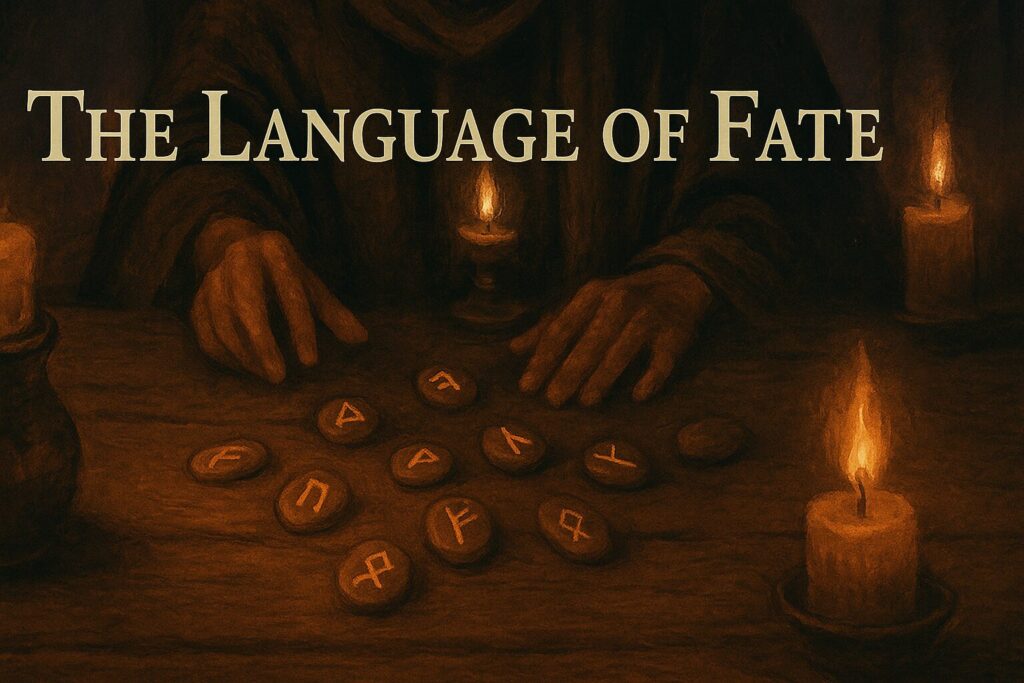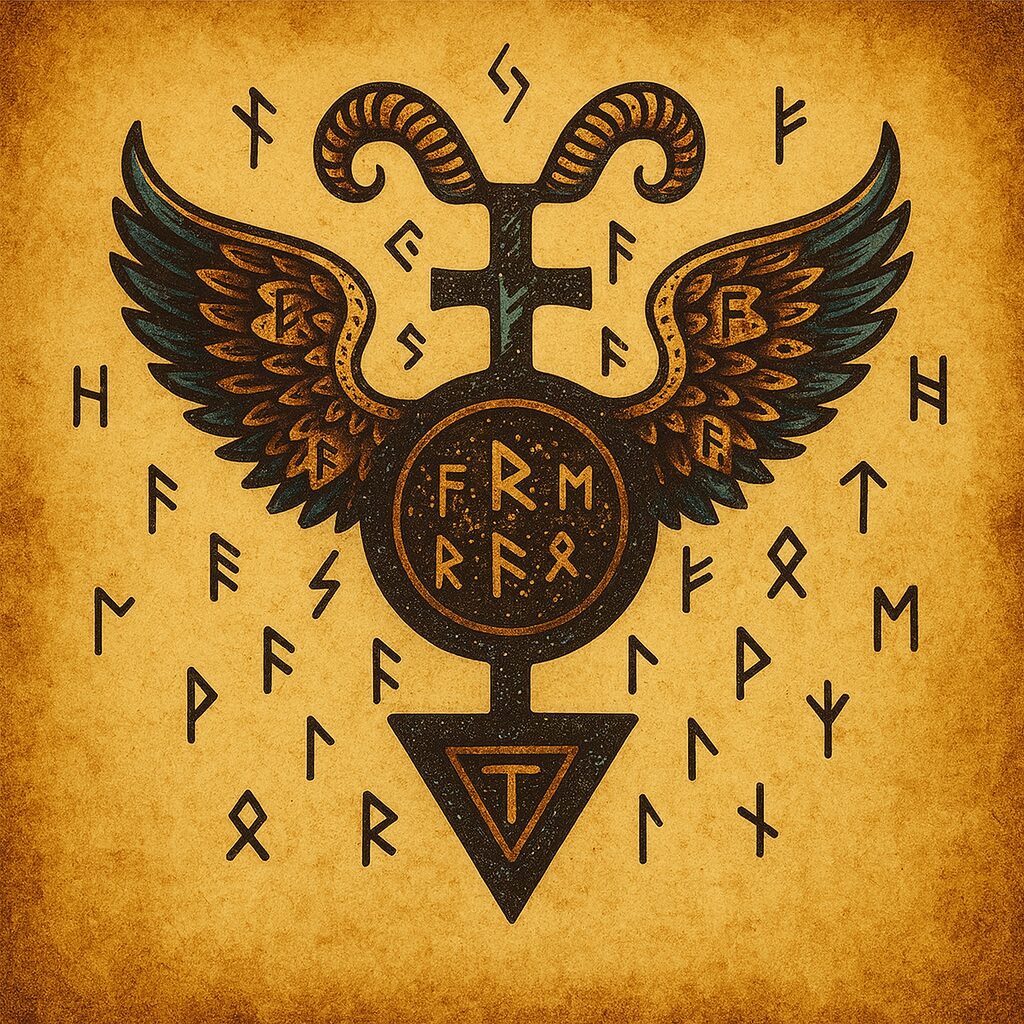Runes and Casting Lots

To cast the runes or throw the lots is to speak with the oldest voice of divination — the voice of the stones, the bones, the carved word. Before ink, before paper, before cards and pendulums, humankind learned to read the world through the fall of objects. It was in the random that pattern first appeared; in the unchosen that destiny was glimpsed. To cast lots is to let the hand of the divine arrange chance into meaning.
The rune stones of the North descend from this primal language. The word rune itself means “whisper” or “mystery,” and in the old Germanic world, to carve a rune was to make a mark of power. Each symbol was a sound, an idea, and an invocation — a letter of both alphabet and cosmos. The Elder Futhark, the oldest known sequence, contains twenty-four such sigils, each representing a force of nature and spirit: Fehu (wealth and movement), Ansuz (divine speech), Raidho (journey), Tiwaz (sacrifice and justice), Dagaz (awakening). Together they form a sacred vocabulary of becoming, a code through which the universe reveals itself to those who listen.
In Norse lore, the runes were not invented but discovered. Odin, the god of wisdom and ordeal, hung for nine nights upon the World Tree, pierced by his own spear, seeking the knowledge beneath all creation. When at last he glimpsed the runes in the depths, he seized them with a cry of revelation. Thus, to work with runes is to participate in that same mythic act of sacrifice and awakening — to seek wisdom not through conquest, but through surrender to the pattern that underlies all things.
Casting the runes, like drawing cards or watching a pendulum swing, reveals the interplay between choice and fate. A rune pulled upright may signify strength or opportunity; the same rune reversed might warn of obstruction or internal conflict. But each carries many shades of meaning, and the art lies in reading their conversation with one another. When several are drawn, their arrangement forms a sentence of symbols — a message shaped by both randomness and resonance. The witch does not impose interpretation; she allows the pattern to unfold through intuition and the quiet logic of myth.
Casting lots — whether stones, bones, coins, shells, or sticks — shares the same ancient spirit. The Romans called it sortilege, the casting of fate, and even the early Hebrews used lots to discern divine will. In Africa, the Yoruba practice of obi divination uses the fall of kola nuts to read the orishas’ response; in the Mediterranean, the tossing of knucklebones foretold victory or doom. In every land, the gesture is the same: the diviner releases control, trusting the fall to express what the conscious mind cannot grasp. The hands move, the pieces scatter, and the pattern that emerges is the language of the moment.
In Wicca and witchcraft, runes and lots serve as both divination and magic. Carved or drawn symbols may be charged as talismans, each rune an energy to be invoked rather than merely interpreted. Algiz can be etched on doors for protection, Berkana inscribed on candles for healing or growth, Gebo drawn upon the palm before acts of love or partnership. The runes, when arranged in bind-forms — interlaced sigils merging multiple symbols — become spells in visual form: language condensed into power. The act of drawing them, even for insight, already stirs their vibration in the world.
As a divinatory tool, runes and lots are distinctive in that they emphasize participation with natural forces rather than observation from afar. The materials themselves — wood, stone, clay, or bone — carry the presence of the elements and the earth. Their weight in the hand, their sound upon the altar, their random fall across cloth or soil — all remind the diviner that fate is physical, alive, and interconnected. To work with them is to touch the living alphabet of creation.
The practice also reveals a deeper truth about divination: that meaning is not imposed upon matter, but emerges through relationship. The symbols have power because they are old and shared, yet they speak differently to each practitioner. Over time, a witch’s runes or casting pieces absorb her energy, becoming extensions of her intuition. They darken with oil and handling, their edges wear smooth, and when cast, they respond as familiars rather than objects. Each reading becomes a conversation between the witch, the tool, and the unseen pattern that holds them both.
A simple casting may illustrate this dialogue. A witch asks, “What energy governs the coming season?” Three runes fall upon the cloth: Jera (harvest), Isa (stillness), Laguz (flow). Together they tell of a cycle of fruition tempered by rest, where patience yields renewal — a message both practical and spiritual. The witch then places Laguz upon her altar water bowl for attunement, letting its energy guide her workings until the wheel turns again. The divination becomes ongoing spellcraft; the reading transforms into relationship.
As with all divinatory arts, ethical clarity is essential. The runes answer truthfully but demand respect. They are not fortune-telling toys, but sacred archetypes — forces that respond to reverence, not curiosity alone. To approach them in haste is to receive confusion; to approach them in humility is to hear the whisper of the Norns, the weavers of destiny. The runes do not reveal a single fixed fate but show the threads available to weave. The witch, seeing their pattern, may then choose how to knot or loosen them through will and action.
In this sense, rune casting and lot divination embody the perfect balance of magic and revelation. They invite both surrender and responsibility: to let the pieces fall as they will, and then to respond as a co-creator within the pattern. Every throw is a mirror of cosmic play — the interplay of chance and consciousness, of order emerging from chaos.
To cast the runes is to remember that even the smallest gesture participates in the great design. The fall of a stone, the sound of its landing, the pause before interpretation — all are echoes of creation’s first utterance. The runes speak because the world itself is language, and every act of divination is an attempt to remember the grammar of the divine.

